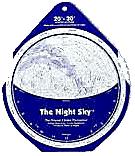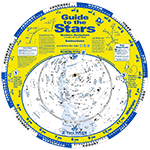|
3
|
Moon near Beehive Cluster (midnight sky) at 9h UT.
• Beehive Cluster (Wikipedia)
• M44: The Beehive Cluster (APOD)
|
|
3
|
Full Moon at 23:09 UT.
|
|
4
|
Moon near Jupiter (midnight sky) at 6h UT. Mag. -2.6.
|
|
5
|
Moon near Regulus (morning sky) at 6h UT.
|
|
6
|
Moon at apogee (farthest from Earth) at 6h UT (distance 406,150 km; angular size 29.4').
|
|
6
|
Jupiter at opposition at 18h UT. Best time to observe the largest planet in the solar system. Mag. -2.6.
• Opposition (Wikipedia)
|
|
9
|
Moon near Spica (morning sky) at 19h UT.
|
|
12
|
Last Quarter Moon at 3:50 UT.
|
|
13
|
Moon near Saturn (morning sky) at 0h UT. Mag. +0.5.
|
|
17
|
Moon near Mercury (26° from Sun, morning sky) at 4h UT. Mag. +0.3.
|
|
18
|
New Moon at 23:47 UT. Start of lunation 1140.
• Lunation Number (Wikipedia)
|
|
19
|
Moon at perigee (closest to Earth) at 7h UT (356,995 km; angular size 33.5').
|
|
21
|
Moon, Venus and Mars within circle diameter 2.0° (28° from Sun, evening sky) at 0h UT. Mags. -4.0 and +1.3.
• Venus-Mars-Moon Triplet (Skymaps)
|
|
21
|
Moon very near Uranus (41° from Sun, evening sky) at 22h UT. Mag. +5.9. Occultation visible from southeast Canada and northeast USA.
• Occultation of Uranus (IOTA)
|
|
22
|
Venus 0.4° SSE of Mars (28° from Sun, evening sky) at 6h UT. Mags. -4.0 and +1.3.
|
|
24
|
Mercury at greatest elongation, 27° west of Sun (morning sky) at 16h UT. Mag +0.1.
|
|
25
|
First Quarter Moon at 17:14 UT.
|
|
25
|
Moon very near Aldebaran (evening sky) at 23h UT. Occultation visible from Scandinavia.
• Occultation of Aldebaran (IOTA)
• Aldebaran (Wikipedia)
|
|
|
The Zodiacal Light is caused by sunlight reflected off meteoric dust in the plane of the solar system. Choose a clear, moonless night, about 1-2 hours after sunset, and look for a large triangular-shaped glow extending up
from the horizon (along the ecliptic). The best months to view the Zodiacal Light is when the ecliptic is almost vertical at the horizon: March and April (evening) and October-November (morning); times reversed for the southern hemisphere.
• Zodiacal Light (Wikipedia)
• Astronomy Picture of the Day (APOD)
• Photographing the Zodiacal Light (Weatherscapes)
|
|
All times Universal Time (UT). USA Eastern Standard Time = UT - 5 hours.
|


